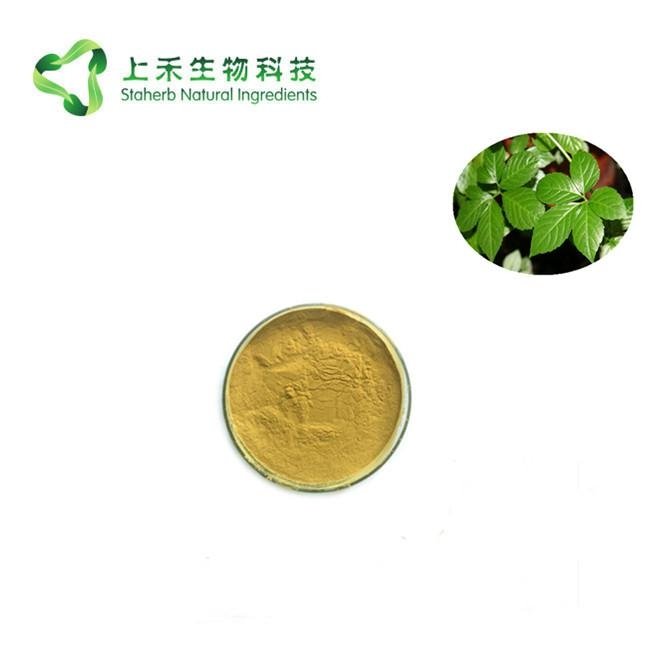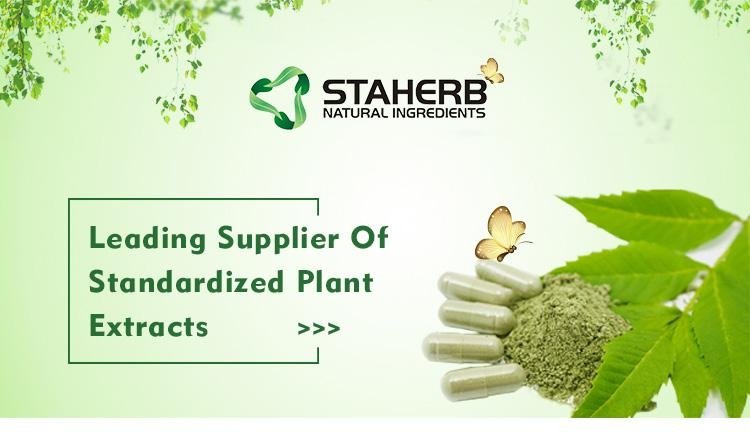
gynostemma pentaphyllum extract
product name:gynostemma extract
Specification:98%
Part used:Whole herb
Appearance:Faint Yellow Powder
Test Method:HPLC

Jiaogulan(Gynostemma) is a powerful adaptogenic herb used by the Chinese for centuries as a "cure all" herb. Belonging to the cucumber family, this anti aging herb and more is also referred to as "southern ginseng" where it is grown traditionally in the mountainous region of South Central China. Gynostemma is widely used in China as an anti aging herb, or a tonic to treat bronchitis, strengthen the body, reduce fatigue, improve sexual vigor, and reinforce overall health.
Functions of extracts
1.Regulating Cholesterol
2.Maintaining healthy blood pressure levels
3.Enhance the contractility of the heart muscle and heart pumping function.
4.Have the ability to support the immune system.It increases the production of Lymphocytes,Phagocytes,and Serum IGG.
5.Adaptogenic Properties: Jiaogulan has a biphasic effect on brain functions, energizing or calming the system depending upon need,as well as on the regulation of hormonal functions in both men and women.he healthy maintenance of these phyiological actions plays a major role in the bodys ability to cope with stress." Suppress experim
Application of extracts
1. Applied in food field, a series of gynostemma tea and drinks are brought to the market;
2. Applied in health product field, to adjust blood pressure and strengthen the immune system .
For more product information pls contact email sales09@staherb.cn
Product Analysis
| Item |
Specification |
Result |
Method |
| Identification |
98% |
98% |
UV |
| Appearance |
Light Yellow Powder |
Light Yellow Powder |
Visual |
| Particle Size |
98% through 80mesh |
Complies |
Sieve 80mesh |
| Odor |
Characteristic |
Characteristic |
Organoleptic |
| Taste |
Characteristic |
Characteristic |
Organoleptic |
| Part Used |
Leaf |
Complies |
N/A |
| Physical Characteristics |
|||
| Loss on Drying |
≤5.00% |
3.85% |
Draco method 1.1.1.0 |
| Ash |
≤5.00% |
3.85% |
Draco method 1.1.3.2 |
| Heavy metals |
|||
| Heavy metals(as Pb) |
USP standards(<10ppm) |
<10ppm |
USP < 231 > |
| Arsenic (As) |
≤2ppm |
0.78ppm |
ICP-OES(CQ-MO-247) |
| Lead (Pb) |
≤2ppm |
1.13ppm |
ICP-OES(CQ-MO-247) |
| Cadmium(Cd) |
≤1ppm |
0.36ppm |
ICP-OES(CQ-MO-247) |
| Mercary(Hg) |
≤0.1ppm |
0.01ppm |
ICP-OES(CQ-MO-247) |
| Pesticide Residue |
Non-detected |
Non-detected |
USP < 561 > |
|
|
|||
| Total Plate Count |
NMT 10000cfu/g |
680 cfu/g |
CP2015 |
| Total Yeast & Mold |
NMT 100cfu/g |
87 cfu/g |
CP2015 |
| E.Coli |
NMT 30cfu/g |
10 cfu/g |
CP2015 |
| Salmonella |
Negative |
Negative |
CP2015 |
References:
-
2.Razmovski-Naumovski et al (2005) Chemistry and pharmacology of Gynostemma pentaphyllum. Phytochem Rev 4(2–3):197–219
-
3.Piao et al (2013) Dammarane-type saponins from heat-processed Gynostemma pentaphyllum show fortified activity against A549 cells. Arch Pharmacal Res 36(7):874–879
-
4.Flora of China Editorial Committee (2011) Flora of China, vol 19. Science Press, Beijing
-
5.Wang et al (2008) Genetic differentiation in endangered Gynostemma pentaphyllum (Thunb.) Makino based on ISSR polymorphism and its implications for conservation. Biochem Syst Ecol 36(9):699–705
-
6.Yu (2003) Artificial cultivation and processing of Gynostemma pentaphyllum. Guangxi Agric Sci 1:51–52 (in Chinese)
-
7.Bi et al (2000) Cultivation techniques of Gynostemma pentaphyllum. Lishizhen Med Materia Medica Res 11(2):191–192 (in Chinese)
-
8.Lu et al (2013) Chemical differentiation of two taste variants of Gynostemma pentaphyllum by using UPLC-Q-TOF-MS and HPLC-ELSD. J Agric Food Chem 61(1):90–97
-
9.Li et al (2012) Isolation and antitumor activities of acidic polysaccharide from Gynostemma pentaphyllum Makino. Carbohydr Polym 89(3):942–947
-
10.Circosta et al (2005) Cardiovascular effects of the aqueous extract of Gynostemma pentaphyllum Makino. Phytomedicine 12(9):638–643
-
11.Zhou (2010) Magic plant in the orient: Gynostemma pentaphyllum. Tea Health 7:50–52 (in Chinese)
-
12.Gu (2010) Southern Ginseng: Gynostemma pentaphyllum. Med People 10:43 (in Chinese)
-
13.Wang (2010) Longevity tea: Gynostemma pentaphyllum. Food Health 8:30–31 (in Chinese)
-
14.Ren (2006) Clinic research of total saponins of Gynostemma pentaphyllum in 80 hyperlipemia patients. Sichuan Med J 27(6):606–607 (in Chinese)
-
15.Zhang et al (2001) Clinic research of total saponins of Gynostemma pentaphyllum in hyperlipemia patients. Northwest Pharm J 16(3):130 (in Chinese)
-
16.Zhang et al (2007) Clinic research of gypenosides on renoprotective effects in patients with early diabetic nephropathy. Herald Med 26(11):1291–1294 (in Chinese)
-
17.Chiranthanut et al (2013) Toxicity evaluation of standardized extract of Gynostemma pentaphyllum Makino. J Ethnopharmacol 149(1):228–234
-
18.Zhang et al (2005) Experimental study on acute toxicity with dripping pills of Gynostemma pentaphyllum in mice. Nei Mongol J Tradit Chin Med 2:31 (in Chinese)
-
19.Attawish et al (2004) Chronic toxicity of Gynostemma pentaphyllum. Fitoterapia 75(6):539–551